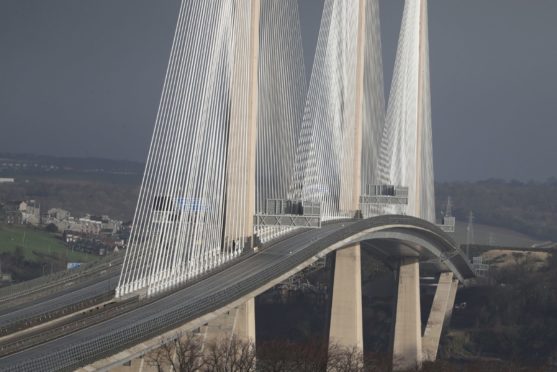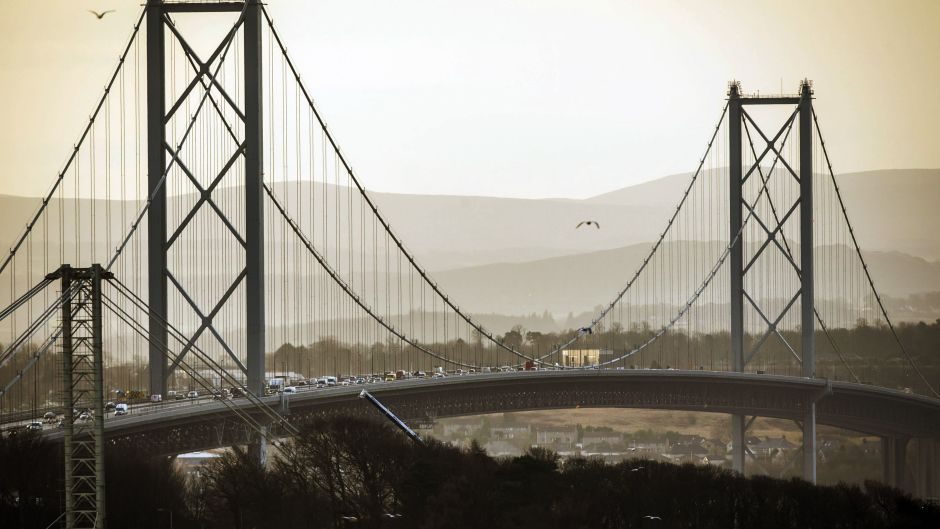Michael Matheson admitted there is “no single solution” to the Queensferry Crossing’s ice bomb problem as he warned bad weather could force the closure of £1.35 billion bridge again.
The Transport Secretary said work was still being done to try to sort out the problem of falling ice which has paralysed traffic between Fife and Edinburgh since Monday night.
At a briefing at Traffic Scotland Control Centre in the shadow of the giant structure, Mr Matheson said it was hoped to reopen the bridge by Wednesday lunchtime, but could give no guarantees.
Latest from Transport Secretary @mathesonmichael at the @trafficscotland National Control Centre today on #Amber weather warning for #snow in southern Scotland and ongoing efforts to reopen the Queensferry Crossing.
Read more: https://t.co/uzhpO60wYR #QueensferryCrossing pic.twitter.com/bBIPVYULXP
— Transport Scotland (@transcotland) February 11, 2020
Mr Matheson also warned that overcoming falling ice in the future would be “challenging”. Meanwhile his opponents accused the Scottish Government of “borderline negligence” for failing to address the problem despite it being raised at Holyrood last year.
The bridge engineers had contacted those running other “cable-stayed” structures elsewhere in the world hoping to find an answer, the Transport Secretary said.
“There is no single solution to it. It is about trying to find a solution that best suits the environment that bridge is operating, which means it is a bespoke type of arrangement,” Mr Matheson said.
Mr Matheson admitted there was “a risk” that the bridge would have to close again if the problem reappeared in another spell of bad weather. But he argued that the new crossing was “more resilient and reliable” than the Forth Road Bridge and had remained open on 34 occasions when the old suspension bridge would have been forced to close.
This is beyond political incompetence – it’s now borderline negligence and the general public are sick and tired of it”
— Jamie Greene of the Scottish Tories
But Conservative Transport spokesman Jamie Greene said: “Despite repeated promises by SNP ministers that falling ice would not be an issue, the first sign of snow this winter and the bridge is closed to traffic in both directions for a significant period of time.
“This is beyond political incompetence – it’s now borderline negligence and the general public are sick and tired of it.”
Q&A: Queensferry Crossing closure
As motorists curse the bridge’s closure and politicians attack ministers’ handling of the Scottish Government’s flagship project, we try to answer some questions about this latest commuter crisis.
What exactly is the problem?
Ice and snow, which had built up on the Queensferry Crossing’s cables, began to fall from them on to the carriageway. Eight cars were damaged by the falling ice, leading to the closure of the bridge in both directions for safety reasons.
The closure means that motorists travelling between Edinburgh and Fife have had to endure a 34-mile diversion to cross the Forth via the Kincardine Bridge.
⚠️QUEENSFERRY CROSSING UPDATE⚠️ 16:50
CLOSED⛔️ both ways
Journey times👇Northbound via A985 approx 1 hr 35 mins to #M90 J3
To Kinross – 1 hr 25 minsSouthbound queuing at Kincardine Br – time approx 50 min@SETrunkRoads @TheForthBridges pic.twitter.com/TMjmVUpbj1
— Traffic Scotland (@trafficscotland) February 11, 2020
When traffic was stopped from going over the 1.7-mile bridge on Monday night was the first time the structure had been closed since it was opened on August 30 2017.
The accumulation of snow and ice on the cables has been blamed on unusual weather conditions as Storm Ciara sweeps the Forth. Similar weather conditions led to the same problem in March last year when three vehicles had their windscreen smashed by falling ice. On that occasion the bridge remained open.
Is it a design flaw?
Transport Secretary Michael Matheson admitted that falling ice was not identified as a potential problem when the bridge was being designed.
“It wasn’t anticipated as being a problem, which should be experienced on the bridge and that’s why the bridge is constructed in the fashion that it is,” the Transport Secretary said.
But at the same time Mr Matheson denied that this was a “design flaw” when the question was put to him directly. His argument was that the bridge had remained open during the “Beast from the East” and other instances of stormy weather.
The SNP’s opponents, however, have attacked the Scottish Government for failing to get to grips with the problem.
Tory Transport spokesman Jamie Greene has accused ministers of “borderline negligence”, asking why the issue had not been addressed when it was first identified in March last year. Mr Greene pointed out that concerns about falling ice had been raised with Mr Matheson by Holyrood’s Rural Economy Committee in May 2019.
Just in case there is any doubt, this was raised again last May with Mr Matheson. Despite re-assurances thay it would be resolved, a number of cars were damaged yesterday. Luckily no people were. Here’s the transcript of the parliamentary committee meeting. #QueensferryCrossing https://t.co/9YpPFOwZ2b pic.twitter.com/BsCb0p3EIo
— Jamie Greene MSP (@jamiegreeneUK) February 11, 2020
When is the Queensferry Crossing likely to reopen?
The answer to that question is that it depends on the weather. But the hopes are that traffic will start moving again at lunchtime on Wednesday. Although that could be subject to delays if the weather does not improve. Michael Matheson has been liaising with the Met Office, which has a branch at South Queensferry. Teams are inspecting the bridge constantly to report on its safety for traffic.
At his briefing at the Traffic Scotland Control Centre, South Queensferry, Mr Matheson said: “As it stands at the moment the advice from the Met Office is that they expect the weather to be broadly the same as yesterday and that will continue until around lunchtime tomorrow. It is a forecast and that could change that’s why we are continuing to monitor the bridge.”
He added: “The bridge will be open at the first opportunity that it is safe to do so.”
What is “unique” about this week’s weather?
The build-up of snow and ice on the cables was caused by a certain consistency of snow and sleet being blown on to the bridge by squalls blowing through the Forth.
South-westerly winds of between 45 and 50mph were accompanied by temperatures of just below freezing. The conditions led to ice accumulating on the plastic outer sheathes encasing the cables. When it comes to ice gathering on the bridge the surfaces of the sheathes have proved more susceptible to a build-up than other parts of the structure.
The winds resulted in a “freeze/thaw cycle”, which resulted the ice falling on the carriageways. Mr Matheson said that when this phenomenon was first observed in March last year, engineers “had difficulty in understanding fully what has been going on”.
Last year’s falling ice was not seen, so engineers were unable to identify the exact location and circumstances. Over the last 24 hours, however, they have observed the phenomenon much more closely and have a better understanding of what has been happening.
Heat cameras are monitoring the temperature of the bridge to identify when it falls to a level that will result in a snow or ice build-up.
The Forth Road Bridge: can it be used?
Currently the old Forth Road Bridge (FRB) can only be used by public transport vehicles, because it is undergoing renovation work on its main expansion joints. It also has a contraflow in operation. Mr Matheson believes that opening up the old bridge to all traffic would result in increased congestion and lengthy delays.
The Transport Secretary did, however, say that reopening the bridge would be explored in the future and he has instructed his officials to examine that option.
“Once the refurbishment works are completed on the Forth Bridge, it would be possible for it to be used as a diversion route,” Mr Matheson said. “That’s something that I am keen to take away.”
Mr Matheson said the Scottish Government would look at ensuring that maintenance work is not done in the winter so that reopening is possible should the problem happen again.
What did the Scottish Government previously say about the crossing’s ability to withstand the weather?
In 2018, the Scottish Government hailed the Queensferry Crossing as a case study in the government’s adaptability to climate change.
Of the bridge, they said: “The new Queensferry Crossing, the biggest infrastructure project in Scotland in a generation, has already in its first winter of operation proved its wind shielding makes it less susceptible to closure during high winds than the Forth Road Bridge.
“The new bridge is capable of carrying cars during winds gusting up to 100 miles per hour compared to 65 miles per hour on the older bridge. The crossing’s design features make it more resilient to severe weather conditions and a changing climate: the latest and most durable materials; cables that can be replaced with more ease as part of normal maintenance without closing the bridge; and a dehumidification system which reduces moisture and prevents corrosion.”
Before it opened, bridge operators said its protections against the wind should “almost entirely eliminate the need for closures”.
The same thing has happened abroad hasn’t it? How did they fix it?
Falling ice has been a problem on other “cable-stayed” bridges, most notably in Canada and Scandinavia. In Scandinavia closing the bridge tends to be the way that the authorities deal with falling ice. But an ingenious solution has been found on the Port Mann Bridge, near Vancouver. On the bridge spanning the Fraser River, a system of collars has been installed by the contractors.
The collars are chains that fit around the bridge cables. They are released down the cables, removing snow and ice.
As they move down the length of the cables, snow and ice is scraped off.
Unfortunately that particular solution is not suitable for the Queensferry Crossing. Michael Matheson said the sheaths which enclose the Queensferry Crossing’s cables prevented that method from being used. The specially designed sheaths have been installed to make the bridge more aerodynamic so that it can withstand high winds, so it is kept open in hostile weather.
“If you were to drop chains down them like you do in Vancouver, it would damage the aerodynamic sheaths that are on the cables,” Mr Matheson said.
The bridge designers and engineers are in touch with other bridges around the world in an effort to come up with a solution. In the meantime ice sensors are to be installed in the next couple of months to help identify snow and ice build-up.
Mr Matheson added: “Experience from other parts of the world would say that can be challenging and any measure that you put in place has to be bespoke to the circumstances and the environment in which that bridge is operating.”

